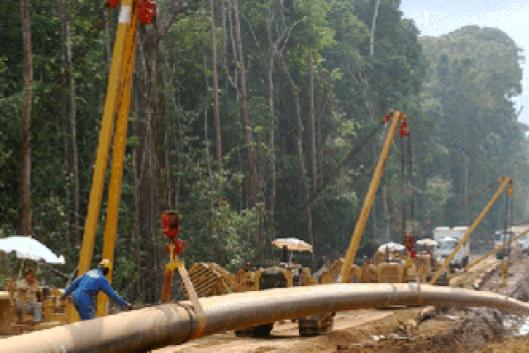If you asked someone to list some of the main causes of rainforest deforestation, they would probably mention, for example, logging, mining, oil and gas extraction, extensive livestock farming, or industrial agriculture. You would be much less likely to hear someone talk about infrastructure projects in sectors like transportation and energy. But these projects are essential for the extraction, storage and/or export of minerals, timber, oil and gas, soybeans, meat, electricity, etc. outside of the forest areas and outside the country, to the world’s large centres of production and consumption.
WRM decided to devote this special bulletin to the subject of infrastructure and forests due to this fundamental link between infrastructure and activities that cause deforestation. If infrastructure constitutes the basis or foundation of a system, we can conclude that this system that is served by the infrastructure, is destructive, because it results in destroyed forests. And this deforestation is not only caused by open-pit mining or the clearing of large areas for cattle grazing. It also results from infrastructure construction itself in the middle of forests, where highways, gas and oil pipelines, electrical power lines, etc. comprise a truly interconnected network of destruction.
Conflicts between the companies constructing large-scale infrastructure works and the communities who depend on the forests affected by these works are already widespread and will expand even more. It is predicted that in the coming decades activities like mining, gas and oil extraction, livestock grazing and industrial agriculture in rainforest areas will double or even triple (see WRM Bulletin 188). This means there will be a proportionate increase in the construction of infrastructure like large-scale hydroelectric dams, highways, railways, riverways and ports. To make matters worse, we contribute to these works through the taxes we pay, which are turned into subsidised loans for these types of projects, granted by public national development banks and multilateral institutions. In addition, a growing number of pension funds and other investment funds now form part of the financial market system and invest in infrastructure.
Many local communities are waging hard-fought struggles against destructive projects, including infrastructure projects. In this bulletin, we offer information to provide readers with an overall view of the infrastructure plans of the main rainforest regions and countries of Latin America, Africa and Asia. We also analyse trends like the growing financialization and privatization of infrastructure projects, which have two goals: increasing profits for the shareholders in the companies involved in these undertakings and financial market investors, and further accelerating the execution of these projects.
Faced with this rather bleak situation, we believe it is important to initiate a discussion on what kind of infrastructure we want and for whose benefit, as well as what infrastructure represents for communities who live in forests. At times, these communities are invited to events like so-called public hearings or “consultations” on the construction of an oil pipeline, a new highway or a hydroelectric dam. But the implementation of these projects is usually a foregone conclusion that rules out the possibility of a genuine and serious consultation. It is much rarer for governments to approach these communities to listen to what they think about infrastructure, that is, what they need to strengthen the foundations that really help to improve their lives – for example, with regard to the economy, health care, education, transportation, energy and communication. Rarely do governments bother to learn about the problems that communities face or address the demands made on the basis of their realities. But they exercise a great deal of discipline in meeting the construction schedules for the infrastructure wanted and demanded by big companies.
Plans formulated with communities on the basis on their demands would probably be good plans, aimed at improving their quality of life, because they would be based on local realities, and it is highly unlikely that their cost would come even close to that of the multimillion-dollar infrastructure projects undertaken for the benefit of the owners of mining, oil, gas, logging and agribusiness companies. Moreover, these projects leave behind debts in the countries where they are undertaken, which we will all have to pay off in the future, above and beyond the destruction they leave in their wake in the forests. These types of infrastructure projects do not create a solid base or build any sort of foundation for communities who depend on forests, because they destroy future prospects.
We hope that the communities affected by these large-scale projects – increasingly better informed – will continue to be able to organize, join efforts and fight back even more strongly, so that their struggles against destructive projects, including infrastructure projects, are strengthened, and their visions and proposals regarding the infrastructure they really want and need can begin to prevail. And that we support these efforts!
